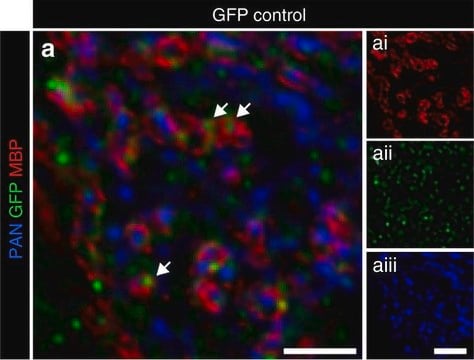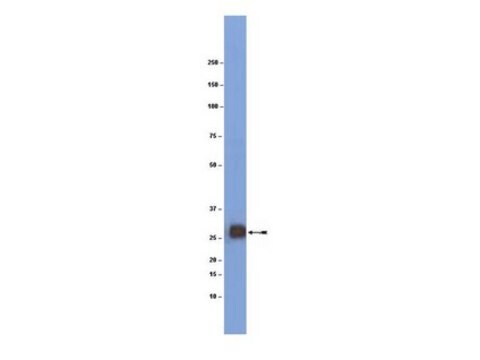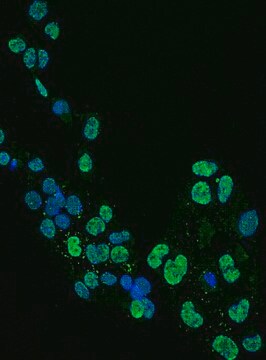MAB382
Anti-Myelin Basic Protein Antibody, a.a. 129-138, clone 1
culture supernatant, clone 1, Chemicon®
Synonym(s):
Myelin A1 protein, Myelin membrane encephalitogenic protein, myelin basic protein
About This Item
IHC (p)
RIA
WB
immunohistochemistry (formalin-fixed, paraffin-embedded sections): suitable
radioimmunoassay: suitable
western blot: suitable
Recommended Products
biological source
mouse
Quality Level
antibody form
culture supernatant
antibody product type
primary antibodies
clone
1, monoclonal
species reactivity
bovine, rat, rabbit (weakly), human
should not react with
guinea pig
manufacturer/tradename
Chemicon®
technique(s)
ELISA: suitable
immunohistochemistry (formalin-fixed, paraffin-embedded sections): suitable
radioimmunoassay: suitable
western blot: suitable
isotype
IgG2a
NCBI accession no.
UniProt accession no.
shipped in
dry ice
target post-translational modification
unmodified
Gene Information
human ... MBP(4155)
rat ... Mbp(24547)
General description
MBP isoforms are found in both the central and the peripheral nervous system, whereas Golli-MBP isoforms are expressed in fetal thymus, spleen and spinal cord, as well as in cell lines derived from the immune system.
Isoform 1 Golli-MBP1, HOG7, 33 kDa
Isoform 2 Golli-MBP2, HOG5, 21.5 kDa
Isoform 3 MBP1, 21.5 kDa
Isoform 4 MBP2, 20.2 kDa
Isoform 5 MBP3, 18.5 kDa
Isoform 6 MBP4, 17.2 kDa
(SP_P02686)
Specificity
Immunogen
Application
Optimal Staining With Citrate Buffer, pH 6.0, Epitope Retrieval: Rat Cerebellum
Immunohistology on frozen sections at 1:10
Western Blot Analysis:
A previous lot of this antibody was used in Western Blot.
ELISA:
A 1:200-1:1,000 dilution of a previous lot was used in ELISA.
RIA:
A previous lot of this antibody was used in Radioimmunoassay.
Optimal working dilutions must be determined by end user.
Neuroscience
Neuronal & Glial Markers
Neurochemistry & Neurotrophins
Quality
Immunohistochemistry(paraffin) Analysis:
MBP (cat. # MAB382) staining pattern/morphology in rat cerebellum. Tissue pretreated with Citrate, pH 6.0. This lot of antibody was diluted to 1:50, using IHC-Select Detection with HRP-DAB. Immunoreactivity is seen as fiber staining in the junction between granular layer and molecular layer.
Optimal Staining With Citrate Buffer, pH 6.0, Epitope Retrieval: Rat Cerebellum
Target description
Physical form
Storage and Stability
Handling Recommendations: Upon receipt, and prior to removing the cap, centrifuge the vial and gently mix the solution. Aliquot into microcentrifuge tubes and store at -20°C. Avoid repeated freeze/thaw cycles, which may damage IgG and affect product performance.
Analysis Note
Brain tissue
Other Notes
Legal Information
Disclaimer
Not finding the right product?
Try our Product Selector Tool.
recommended
Storage Class Code
10 - Combustible liquids
WGK
WGK 1
Certificates of Analysis (COA)
Search for Certificates of Analysis (COA) by entering the products Lot/Batch Number. Lot and Batch Numbers can be found on a product’s label following the words ‘Lot’ or ‘Batch’.
Already Own This Product?
Find documentation for the products that you have recently purchased in the Document Library.
Our team of scientists has experience in all areas of research including Life Science, Material Science, Chemical Synthesis, Chromatography, Analytical and many others.
Contact Technical Service





